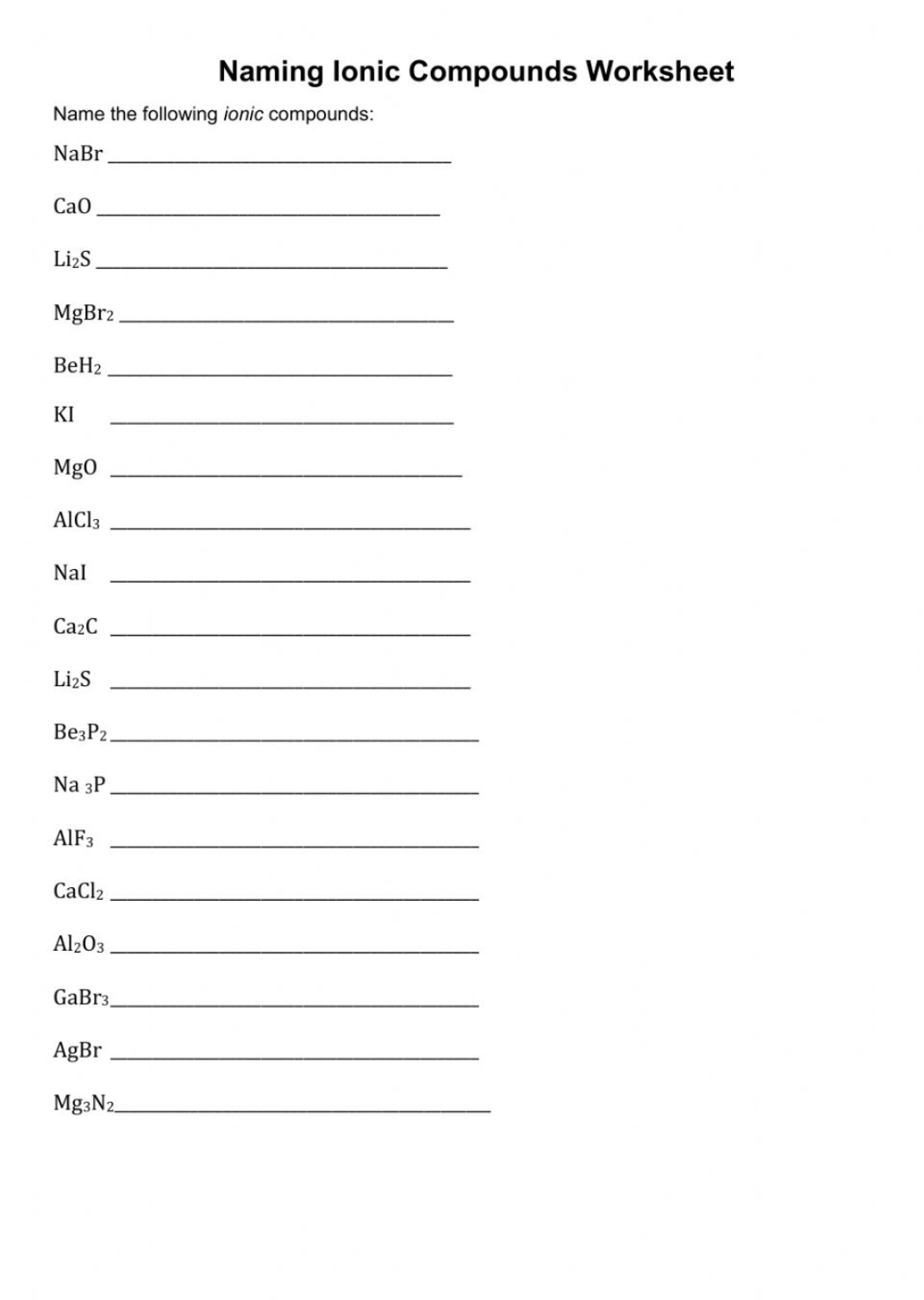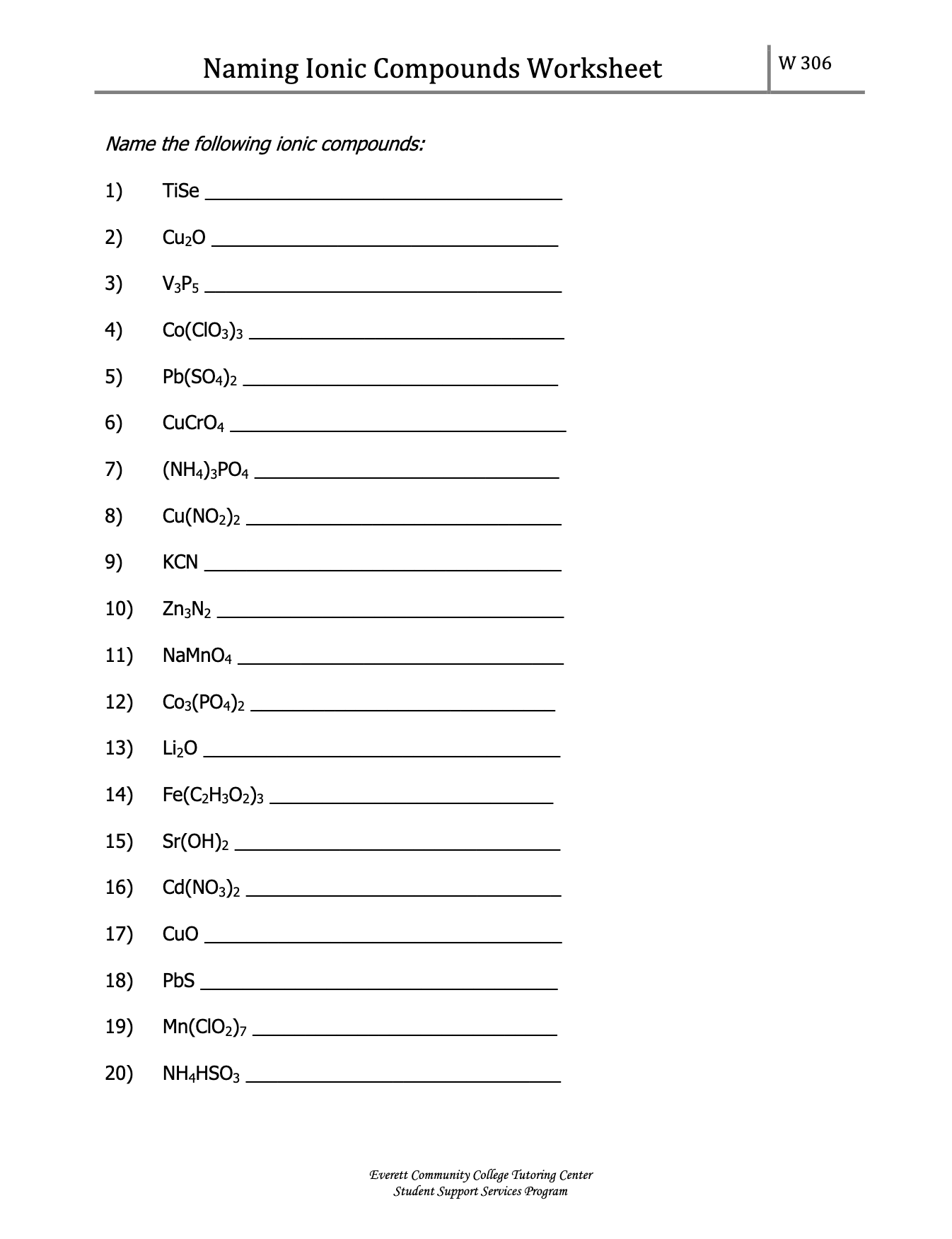Naming Ionic Compounds Worksheets – Naming ionic compounds is an essential part of studying Chemistry. Understanding how to name and write formulas for ionic compounds is essential for understanding the properties and reactions of these compounds. In this worksheet, we will cover the basics of naming ionic compounds and writing chemical formulas.
What are Ionic Compounds?
Ionic compounds are compounds made up of ions. An ion is an atom or a group of atoms that has a net positive or negative charge. Ionic compounds are made up of a positively charged ion (called a cation) and a negatively charged ion (called an anion). The ionic bond is the force of attraction between these oppositely charged ions.
Naming Ionic Compounds
Naming ionic compounds involves following a set of naming rules. The name of the cation comes first, followed by the name of the anion. The name of the cation is simply the name of the metal element. For the anion, we use the root name of the nonmetal element and add the suffix “-ide”. For example, the compound made up of sodium cations and chlorine anions is named sodium chloride.
Naming Binary Ionic Compounds
Binary ionic compounds are made up of two elements. To name a binary ionic compound, we follow the naming rules mentioned above. For example, the compound made up of calcium cations and oxygen anions is named calcium oxide.
Naming Ionic Compounds with Polyatomic Ions
Polyatomic ions are groups of atoms that have a net positive or negative charge and act as a single unit in chemical reactions. To name ionic compounds with polyatomic ions, we follow the same naming rules as for binary ionic compounds. For example, the compound made up of ammonium cations and sulfate polyatomic ions is named ammonium sulfate.
Naming Ionic Compounds with Transition Metals
Transition metals are metals that have multiple oxidation states. To name ionic compounds with transition metals, we use Roman numerals to indicate the oxidation state of the metal ion. The name of the cation is followed by the name of the anion, as in the naming of binary and polyatomic ionic compounds. For example, the compound made up of iron (III) cations and oxide anions is named iron (III) oxide.
Writing Ionic Formulas
Writing formulas for ionic compounds involves combining the ions to form a neutral compound. The charge on the cation must balance the charge on the anion to form a neutral compound.
Writing Formulas for Binary Ionic Compounds
To write the formula for a binary ionic compound, we use the charges on the ions to determine the subscripts needed for each ion. The subscript of the cation is the same as the absolute value of the anion’s charge, and the subscript of the anion is the same as the absolute value of the cation’s charge. For example, the formula for the compound made up of aluminum cations and chloride anions is AlCl3.
Writing Formulas for Ionic Compounds with Polyatomic Ions
To write the formula for an ionic compound with polyatomic ions, we use the same method as for binary ionic compounds. We balance the charges of the ions to form a neutral compound. For example, the formula for the compound made up of calcium cations and phosphate polyatomic ions is Ca3(PO4)2.
Writing Formulas for Ionic Compounds with Transition Metals
To write the formula for an ionic compound with transition metals, we use the same method as for binary and polyatomic ionic compounds. We balance the charges of the ions to form a neutral compound, using the Roman numeral to indicate the oxidation state of the transition metal. For example, the formula for the compound made up of iron (III) cations and oxide anions is Fe2O3.
Conclusion
Naming and writing formulas for ionic compounds is an important skill in Chemistry. This worksheet provides an introduction to the basic concepts of naming ionic compounds and writing chemical formulas for them. By practicing the exercises in this worksheet, students will develop a solid understanding of chemical nomenclature and the properties and reactions of ionic compounds.
Naming Ionic Compounds Worksheets

